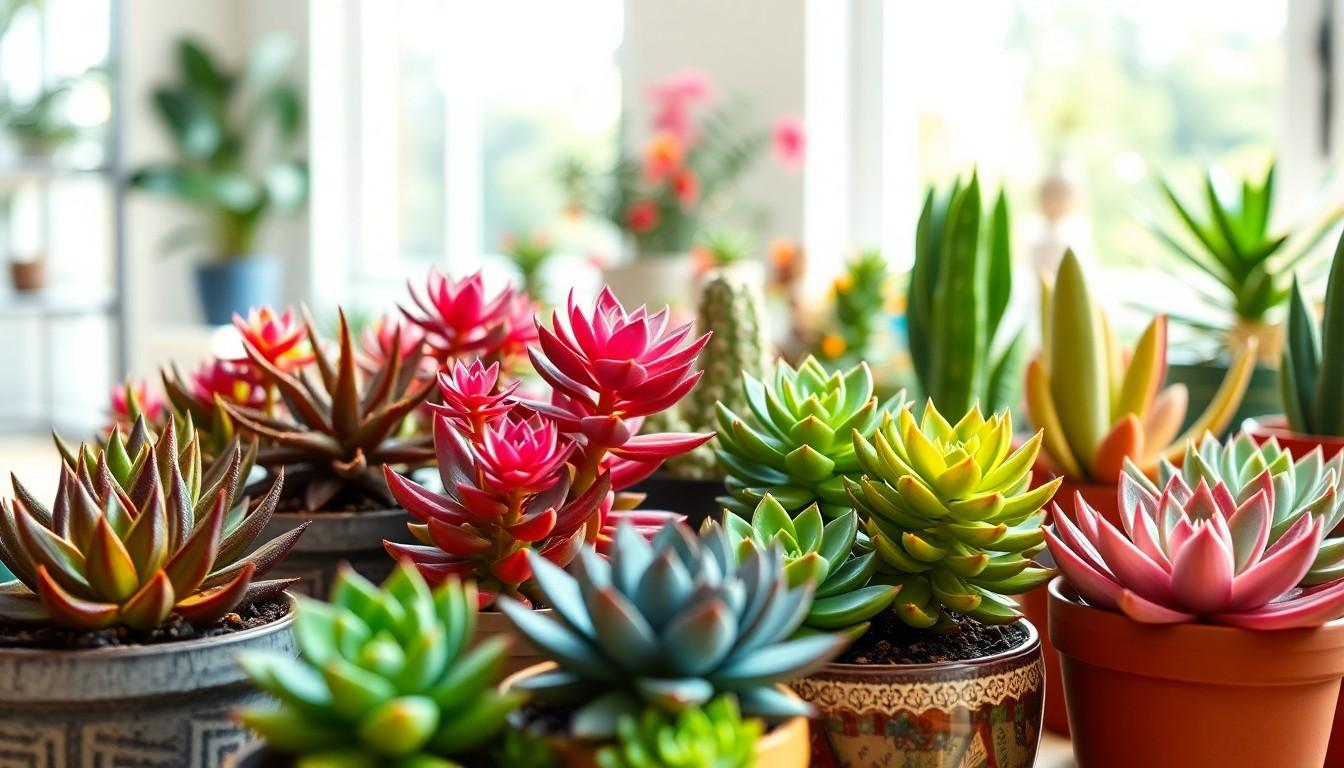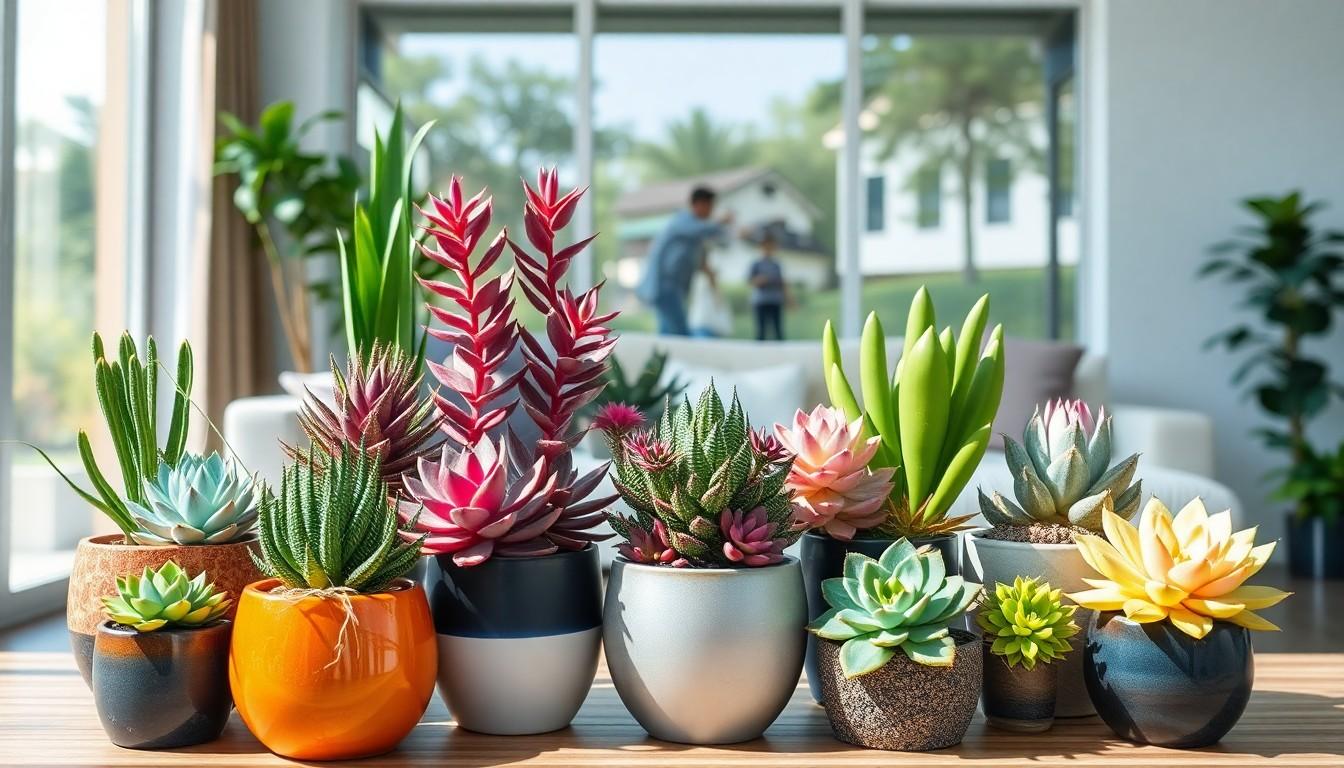Indoor plants have a magical way of transforming a dull space into a vibrant oasis. Among the green wonders, succulent indoor plants stand out like the cool kids at a party. With their quirky shapes and low-maintenance charm, they’re perfect for anyone who wants to add a touch of nature without the commitment of a pet goldfish.
Overview Of Succulent Indoor Plants
Succulent indoor plants belong to a diverse family known for their unique ability to store water in their leaves, stems, or roots. This adaptation allows them to thrive in various environments, especially in indoor settings with varying light conditions. Common varieties include Echeveria, Haworthia, and Aloe Vera, each bringing distinctive shapes and colors that create visual interest.
Maintaining these plants is straightforward, as they require minimal care. A well-draining potting mix, ample sunlight, and infrequent watering lead to success in growth. Ideally, water the plants only when the soil dries out completely. Moisture accumulation can lead to root rot, a common issue that gardeners face.
Succulents also contribute to improved indoor air quality. Research shows that many succulent species filter toxins and release oxygen, creating a healthier living environment. Grouping plants can enhance their visual appeal, making a striking statement in any room.
Habitats for succulents vary widely, so placement can greatly influence their health. A south-facing window is often ideal, although they can adapt to lower light levels. Some varieties thrive in low light environments, making them suitable for offices and bedrooms.
Incorporating succulent indoor plants into home decor adds both aesthetic value and practicality. Their resilience and beauty make them popular choices among both novice and experienced plant enthusiasts. With the right care, these plants can offer enjoyment and a touch of nature, transforming spaces into vibrant indoor jungles.
Benefits Of Succulent Indoor Plants

Succulent indoor plants offer various advantages for both the home environment and plant care enthusiasts.
Low Maintenance Care
Succulents require minimal attention. They thrive with infrequent watering, usually every 1 to 3 weeks, depending on humidity and temperature. A well-draining potting mix prevents root rot, ensuring plant health. Light requirements vary; most succulents favor bright, indirect light, making them suitable for various spaces. Some resilient varieties can tolerate lower light levels, allowing flexibility in placement. This low maintenance nature appeals to busy individuals or those new to plant care. With just a little observation, they flourish, bringing a sense of accomplishment without extensive effort.
Aesthetic Appeal
Visual interest defines succulents. Their unique shapes and forms create eye-catching displays in homes. Choosing from varieties like Echeveria, Haworthia, and Aloe Vera allows personalization of decor. Colors range from refreshing greens to bold reds and purples, enhancing any environment. Grouping different succulents in decorative pots adds depth and texture to arrangements. Their ability to adapt to various indoor styles suits both modern and traditional settings, enriching the overall ambiance. Succulents bring nature indoors, transforming spaces into inviting retreats.
Popular Varieties Of Succulent Indoor Plants
Succulent indoor plants come in various appealing varieties, each with unique characteristics that enhance indoor spaces.
Echeveria
Echeveria showcases rosette-shaped leaves that create a stunning visual display. This variety thrives in bright, indirect light, making it ideal for window sills. Grown in well-draining soil, Echeveria requires watering every 1 to 2 weeks, allowing the soil to dry between sessions. Numerous varieties, such as Echeveria ‘Lola’ and Echeveria ‘Perl von Nurnberg,’ offer varying colors, ranging from pale green to vibrant pink. Their captivating shape and color make Echeveria a popular choice for succulent arrangements.
Haworthia
Haworthia features thick, fleshy leaves that often have distinctive white stripes or patterns. This variety adapts well to low light, making it perfect for indoor environments with indirect sunlight. Overwatering Haworthia can cause root rot, so allowing the soil to dry out completely before watering becomes essential. Numerous hybrids exist, including Haworthia fasciata and Haworthia attenuata, each showcasing unique leaf textures. Due to their resilience and appearance, Haworthia enhances tabletop decor or adds greenery to office spaces.
Jade Plant
Jade Plant, known scientifically as Crassula ovata, embodies a classic succulent with its thick, glossy leaves and tree-like structure. This variety requires bright light for optimal growth, though it can also tolerate lower illumination. Watering every 2 to 3 weeks suffices, provided the soil remains dry between waterings. Many culture Jade Plants for their reputed luck-bringing properties, making them thoughtful gifts. Their attractive form and ease of care contribute to their popularity among novices and experienced plant enthusiasts alike.
Tips For Caring For Succulent Indoor Plants
Succulent indoor plants require specific care to thrive. Following these guidelines ensures healthy and vibrant plants.
Ideal Light Conditions
Light conditions play an essential role in a succulent’s health. Most succulents prefer bright, indirect sunlight. For example, Echeveria thrives under these light conditions, showcasing vibrant colors. Haworthia, on the other hand, tolerates low-light environments. Place succulents near a south or east-facing window for optimal results. Adequate light prevents etiolation, which leads to leggy growth. Observing how plants respond to their environment offers valuable insights for adjustments.
Watering Guidelines
Watering guidelines are crucial for succulent care. Typically, these plants require watering every 1 to 3 weeks. When watering, ensure the potting mix dries out completely between sessions. For instance, checking soil moisture to a depth of 1 inch before watering prevents overwatering. Root rot often occurs due to excess moisture, leading to plant decline. Use pots with drainage holes to facilitate excess water removal. Adjust watering frequency based on seasonal changes and humidity levels for optimal care.
Conclusion
Succulent indoor plants offer a perfect blend of beauty and practicality for any home. Their unique shapes and vibrant colors can elevate any space while requiring minimal maintenance. With just a little care and attention, these resilient plants thrive in various conditions, making them ideal for busy lifestyles or those new to indoor gardening.
By incorporating succulents into home decor, individuals can create inviting environments that not only look great but also contribute to improved air quality. Whether it’s a single plant on a windowsill or a curated collection in decorative pots, succulents bring a touch of nature indoors. Embracing these low-maintenance wonders can transform any living space into a serene retreat.

